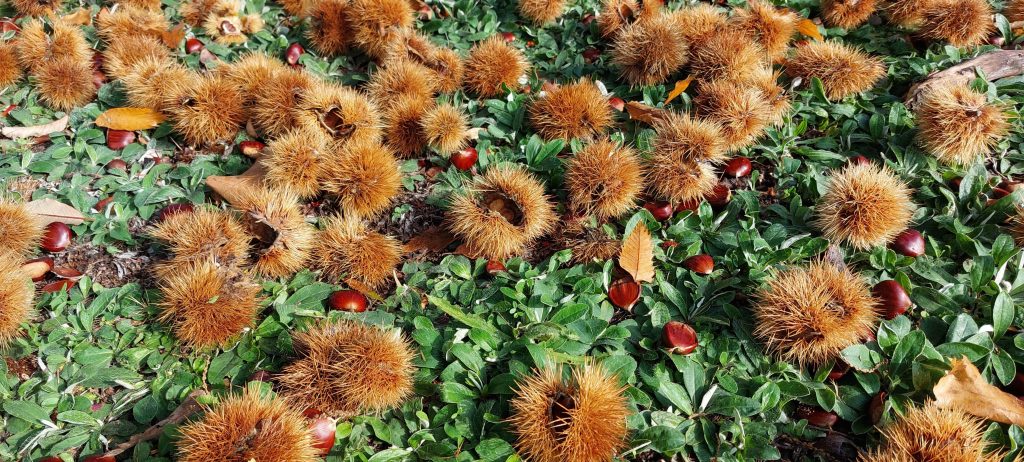
As the days grow shorter and the leaves begin to change, autumn has once again descended upon us, almost as if by surprise. When we think of autumnal fruits, one of the first to come to mind is undoubtedly the chestnut, the fruit of the chestnut tree (scientifically known as Castanea sativa), belonging to the botanical family Fagaceae. It is important not to confuse it with the horse chestnut (Aesculus hippocastanum, family Sapindaceae), used primarily as an ornamental plant, with its seeds colloquially referred to as “conkers”.
For some years, chestnuts were predominantly associated with the problem of the Asian chestnut gall wasp (scientifically known as Dryocosmus kuriphilus), a phytophagous insect originating from the East. This insect lays its eggs on the shoots and leaves of affected plants, causing the formation of round structures known as galls. This stunts the growth of the plants and reduces fruit production. Fortunately, through biological control, involving the introduction of Torymus sinensis, an antagonistic insect also from the East, the chestnut industry has seen a resurgence in recent years. Chestnut harvests have been abundant and of high quality.However, like many other plants, chestnuts continue to be threatened by climate change and the resulting abiotic (caused by extreme environmental factors like drought and high temperatures) and biotic stresses (caused by living organisms such as insects, fungi, and bacteria). This has led to a significant reduction in chestnut cultivation globally. In numerous regions of Italy, including Lombardy, the last few decades have witnessed the abandonment of many chestnut groves and a significant decrease in chestnut utilization.
Since Roman times, chestnuts have been a vital source of food and wood, particularly in mountainous and sub-mountainous areas, due to their multifunctional properties. Until the 20th century, chestnuts were a major productive resource in mountainous regions of Italy. However, in recent decades, demographic decline, habitat fragmentation, and the decline in phytosanitary conditions, primarily due to the aforementioned Asian chestnut gall wasp, have severely degraded Italian chestnut areas. Today, many chestnut groves lay abandoned. Yet, the presence of chestnuts in the hilly and mountainous regions of the Apennines and Prealps, numerous chestnut festivals, and the widespread existence of “century-old chestnuts” and “dedicated museums” all testify to the potential of this species in environmental, social, and productive contexts, particularly for high-quality typical products.
The potential of the chestnut is linked to its multifunctionality, which encompasses productive, ecological, naturalistic, landscape, tourist-recreational, and cultural functions. All of these can contribute to the recovery of “chestnut forests” and the associated marginal territories. Recently, the Academy of Georgofili has established a working group to take appropriate actions to have the chestnut tree declared a UNESCO World Heritage.
In June 2021, the Lombardy Region funded the CASTADIVA project (2014-2021 PSR – FEASR: Conservation of Animal and Plant Biodiversity), a collaboration between research institutions (the National Research Council with its IBBA and IRET Institutes, and the University of Milan) and Lombard chestnut growers’ consortia/groups. The ultimate goal of the project is the enhancement and recovery of Lombard chestnut forests, starting with two pilot areas: the Varese Prealps and the municipality of Serle in the province of Brescia.
The project objectives include:
The work of CASTADIVA takes place in the forests of the Varese Prealps and Brescia (Serle municipality), as well as in the laboratories of the CNR (IBBA in Milan and IRET in Porano) and the University of Milan.
Over the course of the two-year project, various samplings and in situ analyses have been conducted. Initially, thematic maps were created, integrating orographic, climatological, and genetic data. Subsequently, two autumn samplings (in 2021 and 2022) were carried out to collect leaves for genetic analyses and fruits for genetic, morphological, and compositional analyses. Two spring outings (in 2022 and 2023) were also conducted to gather photographic material and morphological data related to leaves and inflorescences. Genetic analyses of leaves and fruits were performed using molecular markers based on the different lengths of short DNA sequences called SSR (Single Sequence Repeats). This allowed us to understand the genetic relationships among various plants in seven municipalities of the Varese Prealps and two locations in the Serle municipality. The plants were then subdivided into subgroups for morphological analyses of fruits, leaves, and inflorescences, as well as for fruit composition analysis.
Chestnuts are primarily composed of starch, representing a good energy source, but the sweetness of the fruit is determined by its sucrose content. Among the various samples, differences in both sucrose and raffinosaccharide content (sugars that can cause flatulence when consumed) were observed. Statistical analysis of all the data obtained is still ongoing, but preliminary results suggest that, in addition to genetics, the environment appears to significantly influence fruit characteristics.
In December 2022, the Lombardy Region funded a new project, CASTANEVAL, involving the same partners as CASTADIVA. Within CASTANEVAL, we are furthering the analyses initiated in CASTADIVA and developing the micropropagation technique, which allows for the creation of clones from individual chestnut trees with the same genetic heritage.
For those interested in delving deeper, you can find more information on the CASTADIVA project website https://sites.unimi.it/progettocastadiva/.
Authors: Eleonora Cominelli, Chiara Forti, Paolo Alberto Leone